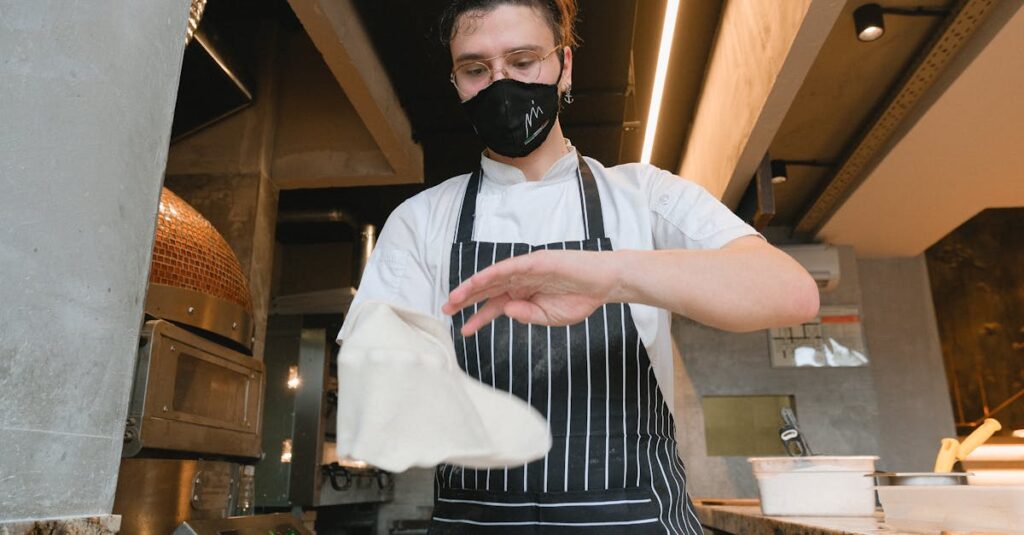Table of Contents
ToggleIn a world where cooking can feel like a high-stakes game show, modern techniques are the secret weapons chefs and home cooks alike are using to elevate their culinary skills. Gone are the days of slaving over a hot stove for hours. Today’s kitchen warriors embrace sous vide, air frying, and even molecular gastronomy to whip up dishes that would make any food critic swoon.
Overview Of Modern Cooking Techniques
Modern cooking techniques revolutionize culinary practices, blending innovation and efficiency. Sous vide involves vacuum-sealing food in a bag and cooking it in a temperature-controlled water bath, ensuring even cooking and enhanced flavor. Air frying utilizes circulating hot air to achieve crispy textures with minimal oil, promoting healthier eating habits.
Molecular gastronomy introduces scientific principles into cooking, altering food at a molecular level to create unique textures and flavor profiles. This technique includes spherification, which forms liquid-filled spheres, and foaming, which incorporates air to create ethereal textures.
Pressure cooking reduces cooking time significantly while retaining nutrients and flavors. This method uses steam to cook food faster, making it ideal for busy cooks looking for speed without sacrificing quality.
Culinary torching provides a quick way to caramelize sugars or create a charred finish on various dishes, enhancing both appearance and taste. Grilling remains popular but evolves with new tools such as pellet smokers, which infuse food with distinct flavors from flavored wood pellets.
Fermentation, an ancient technique, regains popularity, allowing for the production of foods like kimchi and yogurt rich with probiotics. This technique nurtures beneficial bacteria, supporting gut health while adding unique flavors.
Each of these modern cooking techniques caters to diverse culinary preferences and dietary needs, demonstrating how innovation can enhance both home and professional cooking experiences. As technology advances, the culinary world continues to expand, encouraging experimentation and creativity in the kitchen.
Sous Vide Cooking
Sous vide cooking has gained popularity for its precision and ability to enhance flavors. This technique involves vacuum-sealing food in plastic bags and immersing them in a temperature-controlled water bath.
Benefits Of Sous Vide
Sous vide offers numerous benefits for both professional and home cooks. Cooking food at precise temperatures ensures even doneness, eliminating the risk of overcooking. Furthermore, the vacuum-sealing process enhances flavor and tenderness by allowing the food to marinate in its juices. An additional advantage lies in the convenience; food can cook unattended for extended periods, freeing up time for other tasks. Nutrient retention stands out as another key factor, as the controlled environment minimizes the loss of vitamins and minerals.
Equipment Needed
Essential equipment for sous vide cooking includes an immersion circulator and vacuum sealer. An immersion circulator regulates water temperature and maintains consistent heat throughout the cooking process. Various circulators are available, ranging from budget-friendly models to professional-grade ones. A vacuum sealer removes air from the bags, ensuring proper sealing to prevent water from entering. Food-grade plastic bags or reusable silicone pouches work well for sealing the ingredients. A large container, like a pot or cooler, holds the water while allowing ample space for the food to cook evenly.
Molecular Gastronomy
Molecular gastronomy uses scientific techniques to enhance cooking. This approach transforms ingredients, creating innovative textures and flavors.
Key Techniques
Spherification allows chefs to create water-filled spheres that burst in the mouth. Foam techniques incorporate air into liquid ingredients, resulting in light, airy textures. Sous vide cooking, already mentioned, ensures that flavors meld seamlessly. Emulsification blends ingredients with different properties, making sauces and dressings smooth and stable. Gelling techniques utilize agents like agar or gelatin to produce sophisticated presentations. Using an anti-griddle cooks fresh ingredients rapidly, leading to unique culinary results. Each technique combines science and art, permitting culinary creativity.
Popular Dishes
Caviar-like spheres of balsamic vinegar often expand beyond traditional uses. These pearls bring an unexpected burst of flavor to salads and appetizers. Foamed lemon meringue adds delightful lightness to desserts. Deconstructed caprese salad presents tomatoes and mozzarella in a novel way, emphasizing textures. Ravioli, filled with flavored liquids, creates an impressive taste experience when served. Additionally, edible cocktails mix familiar flavors with visually stunning presentations, enhancing dining atmospheres. Each dish demonstrates how molecular gastronomy elevates classic recipes.
Cooking With Fire
Cooking with fire remains a traditional yet innovative technique in modern cuisine. It offers a distinctive flavor profile while providing various cooking methods.
Grilling vs. Smoking
Grilling involves cooking food directly over high heat, producing charred, flavorful exterior layers. This method excels for meats, vegetables, and seafood, achieving quick cook times. Smoking, on the other hand, infuses food with complex flavors by exposing it to low heat and smoke for extended periods. Wood types like oak and hickory contribute unique tastes to the final dishes. Both techniques enhance the overall dining experience, showcasing the chef’s skill and creativity.
Safety Tips
Safety is essential when cooking with fire. Keeping a fire extinguisher nearby ensures quick responses to emergencies. Use long-handled tools to maintain distance from flames, reducing the risk of burns. Maintaining a clean cooking area prevents flare-ups from grease and debris. Additionally, building a controlled fire with proper ventilation minimizes the buildup of dangerous gases. Following these precautions leads to safe and enjoyable cooking experiences.
Food Presentation Techniques
Food presentation significantly impacts the overall dining experience. Creative techniques engage both sight and taste, inviting diners to savor each dish.
Plating Styles
Various plating styles enhance visual appeal. Central placement draws attention to a main component. Layering ingredients creates height and intrigue. Triangular arrangements guide the eye through the plate. Using negative space prevents overcrowding, allowing elements to shine. Colorful sauces or coulis can frame dishes, adding vibrancy. Components arranged in varying heights contribute to a dynamic presentation. Additionally, utilizing contrasting elements—like crisp and creamy textures—enhances the sensory experience. Overall, each technique conveys artistry and thoughtfulness.
Garnishing Ideas
Garnishes elevate dishes and provide finishing touches. Fresh herbs like basil or cilantro add bursts of color and flavor. Edible flowers offer a vibrant, whimsical aspect. Microgreens introduce delicate textures and visual interest. Drizzling oils or flavored reductions not only enhances taste but also adds elegance. Sprinkling seeds or nuts provides a satisfying crunch contrast. Slices of citrus fruit can brighten up a plate with color. Thoughtful garnishing complements the main dish without overpowering it. Each detail, no matter how small, contributes to the overall presentation and enjoyment of the meal.
Modern cooking techniques are reshaping how food is prepared and presented. With methods like sous vide and air frying, chefs and home cooks alike can achieve impressive results with less effort. The fusion of science and culinary art through molecular gastronomy introduces exciting textures and flavors that elevate traditional dishes.
As technology continues to evolve, the culinary landscape will only expand further. The emphasis on innovation not only enhances efficiency but also encourages creativity in the kitchen. Embracing these techniques allows for a more enjoyable cooking experience and opens the door to endless possibilities.




